IT Networking and Communication Assignment - Addressing and Protocols
VerifiedAdded on 2022/11/23
|9
|1937
|86
Homework Assignment
AI Summary
This assignment provides comprehensive answers to a series of questions related to IT Networking and Communication. It covers fundamental concepts such as classful and classless addressing in IPv4, subnetting, and Network Address Translation (NAT). The document delves into the differences between connection-oriented and connectionless services, the purpose of fragmentation, and transition strategies from IPv4 to IPv6, including dual stack and tunneling. It also explores address mapping protocols, the role of ICMP, and the concept of an autonomous system. Furthermore, the assignment explains the purpose and functions of Routing Information Protocol (RIP) messages, and the Border Gateway Protocol (BGP), and the characteristics of distance vector routing. The assignment provides detailed explanations of each concept, making it a valuable resource for students studying IT networking.
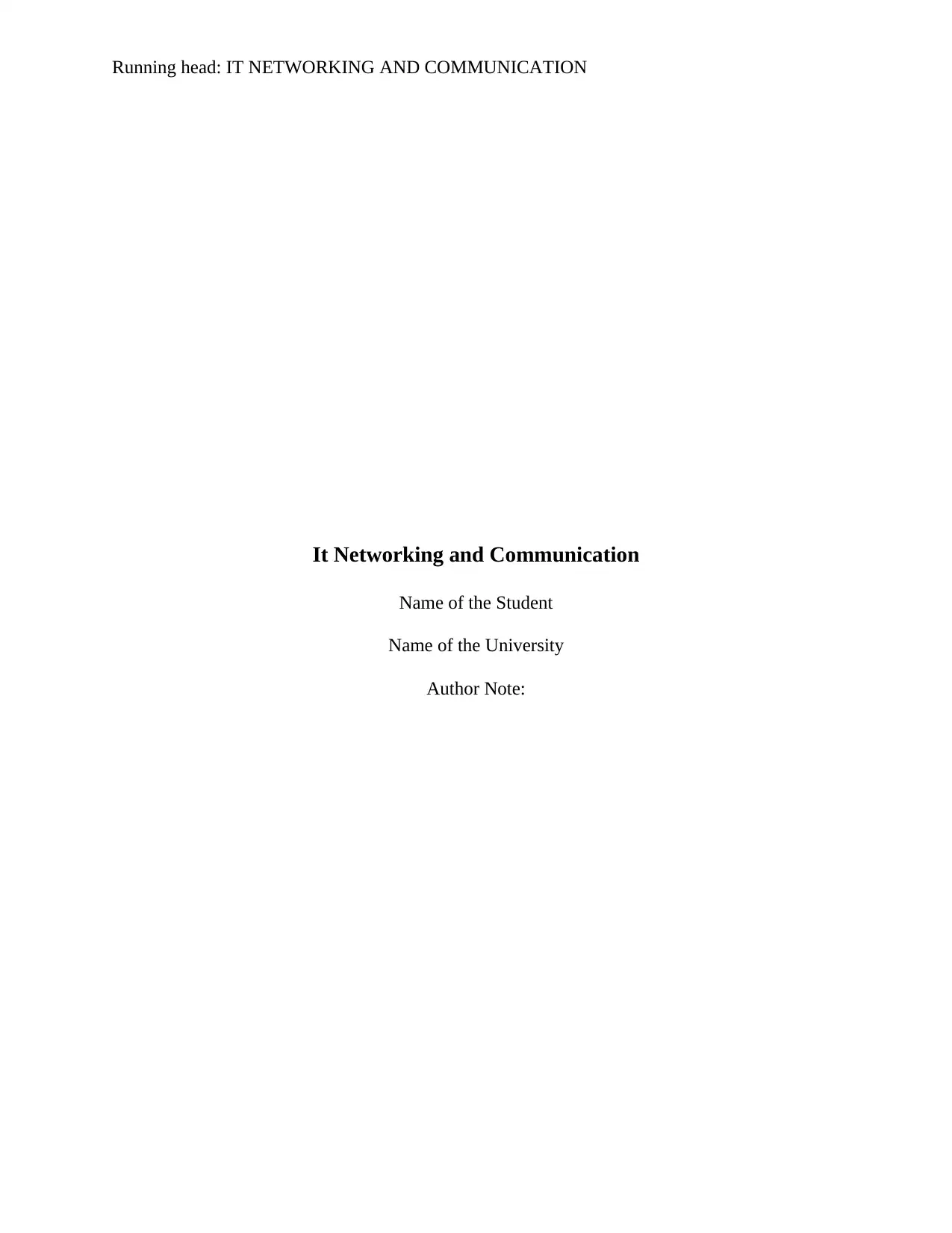
Running head: IT NETWORKING AND COMMUNICATION
It Networking and Communication
Name of the Student
Name of the University
Author Note:
It Networking and Communication
Name of the Student
Name of the University
Author Note:
Paraphrase This Document
Need a fresh take? Get an instant paraphrase of this document with our AI Paraphraser
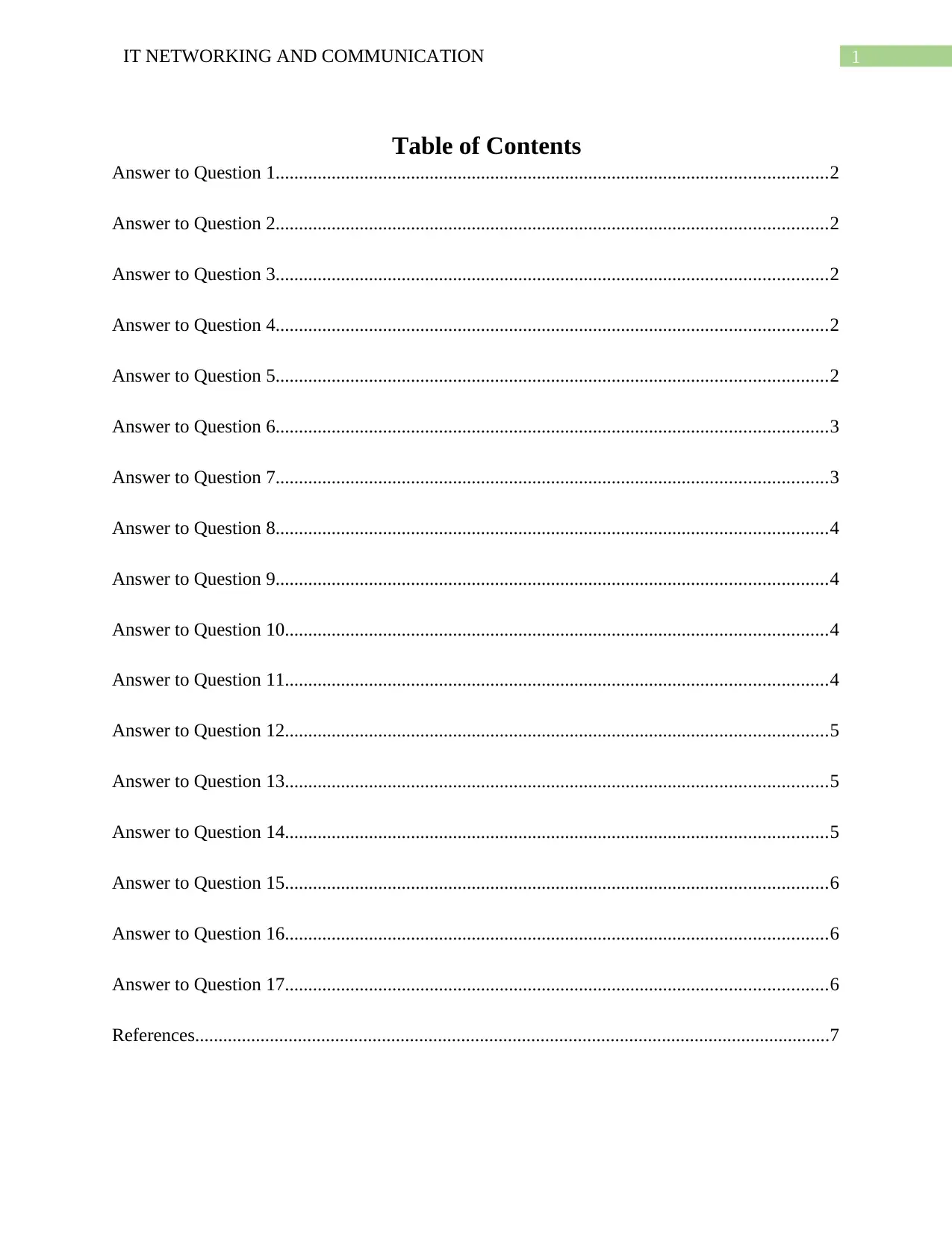
1IT NETWORKING AND COMMUNICATION
Table of Contents
Answer to Question 1......................................................................................................................2
Answer to Question 2......................................................................................................................2
Answer to Question 3......................................................................................................................2
Answer to Question 4......................................................................................................................2
Answer to Question 5......................................................................................................................2
Answer to Question 6......................................................................................................................3
Answer to Question 7......................................................................................................................3
Answer to Question 8......................................................................................................................4
Answer to Question 9......................................................................................................................4
Answer to Question 10....................................................................................................................4
Answer to Question 11....................................................................................................................4
Answer to Question 12....................................................................................................................5
Answer to Question 13....................................................................................................................5
Answer to Question 14....................................................................................................................5
Answer to Question 15....................................................................................................................6
Answer to Question 16....................................................................................................................6
Answer to Question 17....................................................................................................................6
References........................................................................................................................................7
Table of Contents
Answer to Question 1......................................................................................................................2
Answer to Question 2......................................................................................................................2
Answer to Question 3......................................................................................................................2
Answer to Question 4......................................................................................................................2
Answer to Question 5......................................................................................................................2
Answer to Question 6......................................................................................................................3
Answer to Question 7......................................................................................................................3
Answer to Question 8......................................................................................................................4
Answer to Question 9......................................................................................................................4
Answer to Question 10....................................................................................................................4
Answer to Question 11....................................................................................................................4
Answer to Question 12....................................................................................................................5
Answer to Question 13....................................................................................................................5
Answer to Question 14....................................................................................................................5
Answer to Question 15....................................................................................................................6
Answer to Question 16....................................................................................................................6
Answer to Question 17....................................................................................................................6
References........................................................................................................................................7
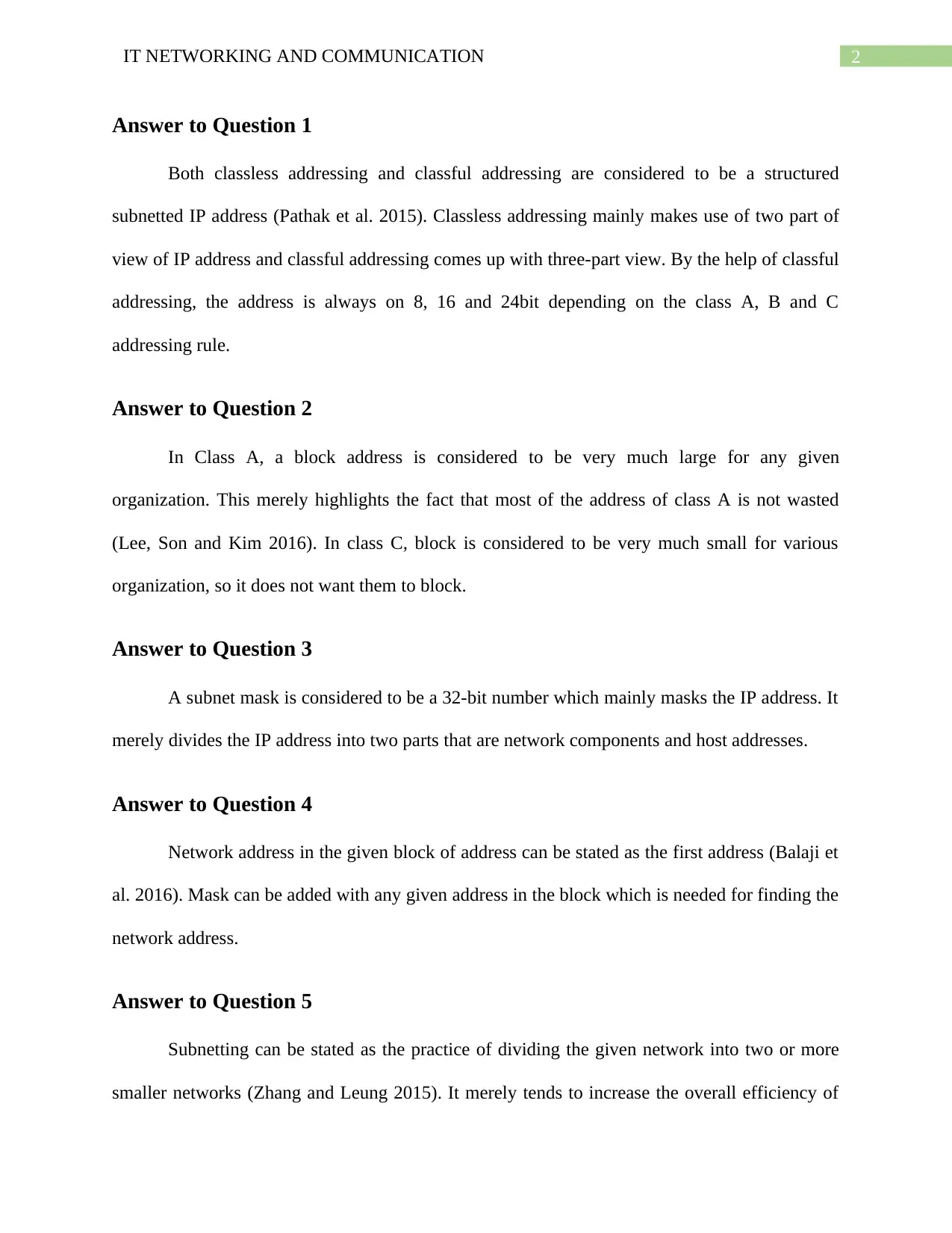
2IT NETWORKING AND COMMUNICATION
Answer to Question 1
Both classless addressing and classful addressing are considered to be a structured
subnetted IP address (Pathak et al. 2015). Classless addressing mainly makes use of two part of
view of IP address and classful addressing comes up with three-part view. By the help of classful
addressing, the address is always on 8, 16 and 24bit depending on the class A, B and C
addressing rule.
Answer to Question 2
In Class A, a block address is considered to be very much large for any given
organization. This merely highlights the fact that most of the address of class A is not wasted
(Lee, Son and Kim 2016). In class C, block is considered to be very much small for various
organization, so it does not want them to block.
Answer to Question 3
A subnet mask is considered to be a 32-bit number which mainly masks the IP address. It
merely divides the IP address into two parts that are network components and host addresses.
Answer to Question 4
Network address in the given block of address can be stated as the first address (Balaji et
al. 2016). Mask can be added with any given address in the block which is needed for finding the
network address.
Answer to Question 5
Subnetting can be stated as the practice of dividing the given network into two or more
smaller networks (Zhang and Leung 2015). It merely tends to increase the overall efficiency of
Answer to Question 1
Both classless addressing and classful addressing are considered to be a structured
subnetted IP address (Pathak et al. 2015). Classless addressing mainly makes use of two part of
view of IP address and classful addressing comes up with three-part view. By the help of classful
addressing, the address is always on 8, 16 and 24bit depending on the class A, B and C
addressing rule.
Answer to Question 2
In Class A, a block address is considered to be very much large for any given
organization. This merely highlights the fact that most of the address of class A is not wasted
(Lee, Son and Kim 2016). In class C, block is considered to be very much small for various
organization, so it does not want them to block.
Answer to Question 3
A subnet mask is considered to be a 32-bit number which mainly masks the IP address. It
merely divides the IP address into two parts that are network components and host addresses.
Answer to Question 4
Network address in the given block of address can be stated as the first address (Balaji et
al. 2016). Mask can be added with any given address in the block which is needed for finding the
network address.
Answer to Question 5
Subnetting can be stated as the practice of dividing the given network into two or more
smaller networks (Zhang and Leung 2015). It merely tends to increase the overall efficiency of
⊘ This is a preview!⊘
Do you want full access?
Subscribe today to unlock all pages.

Trusted by 1+ million students worldwide
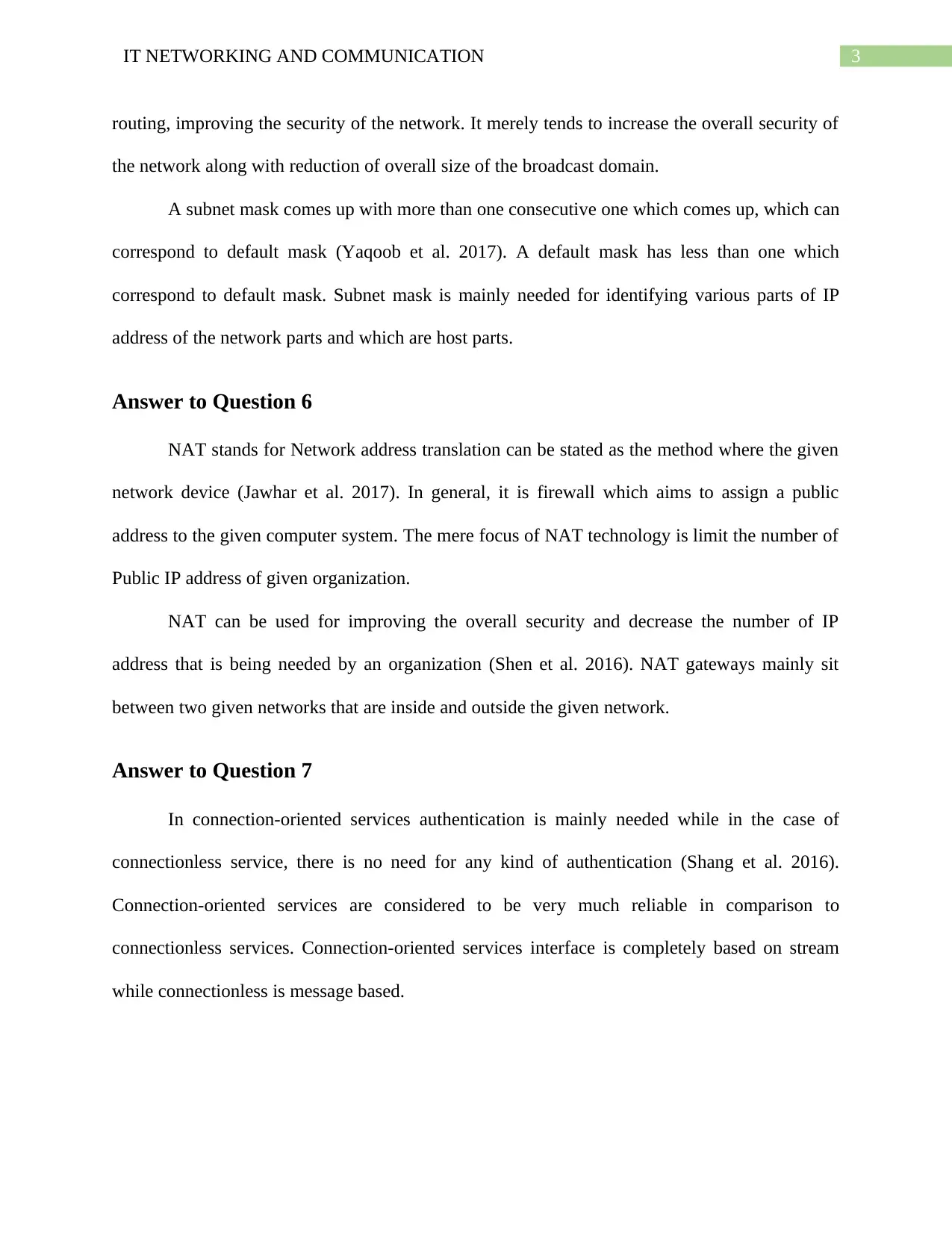
3IT NETWORKING AND COMMUNICATION
routing, improving the security of the network. It merely tends to increase the overall security of
the network along with reduction of overall size of the broadcast domain.
A subnet mask comes up with more than one consecutive one which comes up, which can
correspond to default mask (Yaqoob et al. 2017). A default mask has less than one which
correspond to default mask. Subnet mask is mainly needed for identifying various parts of IP
address of the network parts and which are host parts.
Answer to Question 6
NAT stands for Network address translation can be stated as the method where the given
network device (Jawhar et al. 2017). In general, it is firewall which aims to assign a public
address to the given computer system. The mere focus of NAT technology is limit the number of
Public IP address of given organization.
NAT can be used for improving the overall security and decrease the number of IP
address that is being needed by an organization (Shen et al. 2016). NAT gateways mainly sit
between two given networks that are inside and outside the given network.
Answer to Question 7
In connection-oriented services authentication is mainly needed while in the case of
connectionless service, there is no need for any kind of authentication (Shang et al. 2016).
Connection-oriented services are considered to be very much reliable in comparison to
connectionless services. Connection-oriented services interface is completely based on stream
while connectionless is message based.
routing, improving the security of the network. It merely tends to increase the overall security of
the network along with reduction of overall size of the broadcast domain.
A subnet mask comes up with more than one consecutive one which comes up, which can
correspond to default mask (Yaqoob et al. 2017). A default mask has less than one which
correspond to default mask. Subnet mask is mainly needed for identifying various parts of IP
address of the network parts and which are host parts.
Answer to Question 6
NAT stands for Network address translation can be stated as the method where the given
network device (Jawhar et al. 2017). In general, it is firewall which aims to assign a public
address to the given computer system. The mere focus of NAT technology is limit the number of
Public IP address of given organization.
NAT can be used for improving the overall security and decrease the number of IP
address that is being needed by an organization (Shen et al. 2016). NAT gateways mainly sit
between two given networks that are inside and outside the given network.
Answer to Question 7
In connection-oriented services authentication is mainly needed while in the case of
connectionless service, there is no need for any kind of authentication (Shang et al. 2016).
Connection-oriented services are considered to be very much reliable in comparison to
connectionless services. Connection-oriented services interface is completely based on stream
while connectionless is message based.
Paraphrase This Document
Need a fresh take? Get an instant paraphrase of this document with our AI Paraphraser
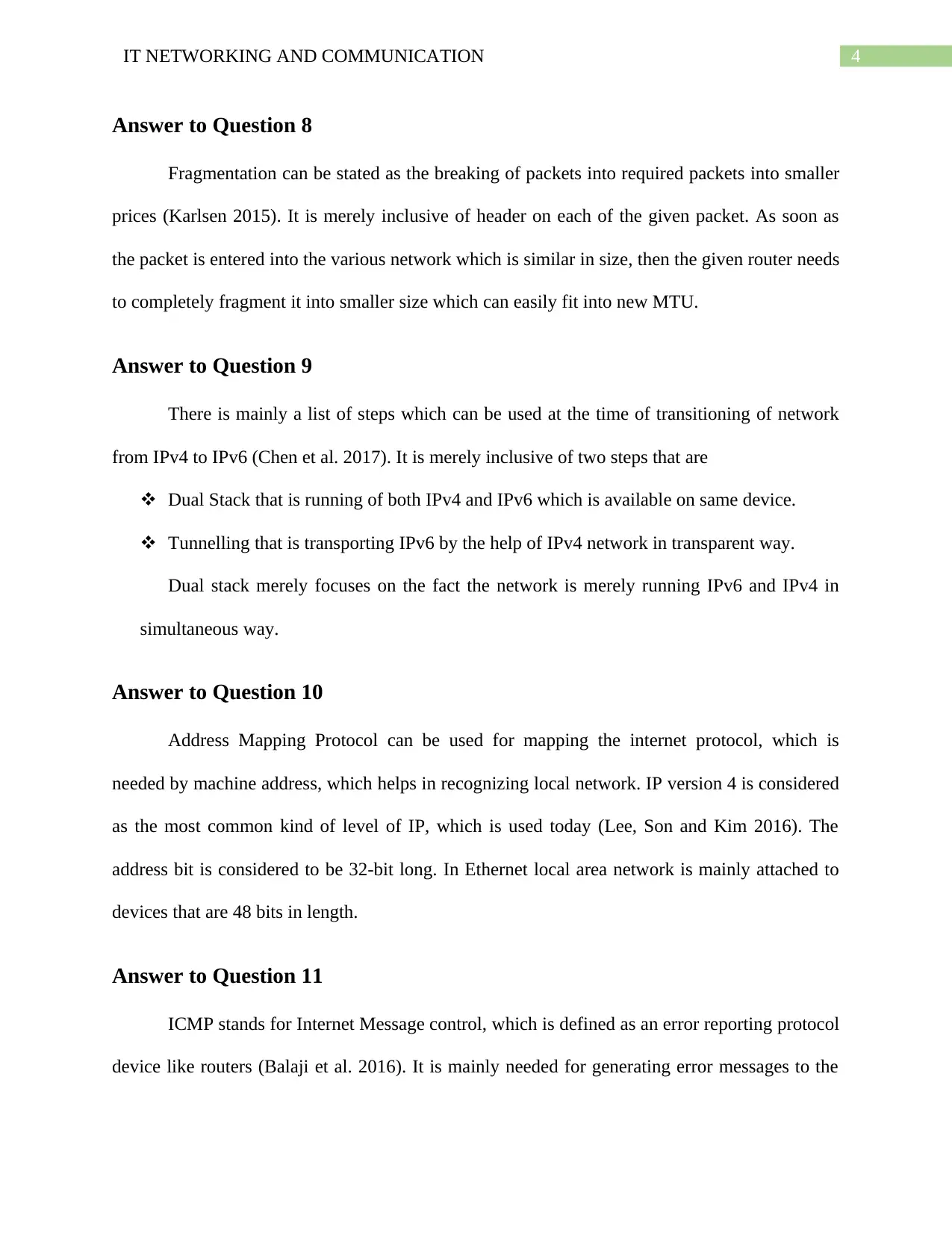
4IT NETWORKING AND COMMUNICATION
Answer to Question 8
Fragmentation can be stated as the breaking of packets into required packets into smaller
prices (Karlsen 2015). It is merely inclusive of header on each of the given packet. As soon as
the packet is entered into the various network which is similar in size, then the given router needs
to completely fragment it into smaller size which can easily fit into new MTU.
Answer to Question 9
There is mainly a list of steps which can be used at the time of transitioning of network
from IPv4 to IPv6 (Chen et al. 2017). It is merely inclusive of two steps that are
Dual Stack that is running of both IPv4 and IPv6 which is available on same device.
Tunnelling that is transporting IPv6 by the help of IPv4 network in transparent way.
Dual stack merely focuses on the fact the network is merely running IPv6 and IPv4 in
simultaneous way.
Answer to Question 10
Address Mapping Protocol can be used for mapping the internet protocol, which is
needed by machine address, which helps in recognizing local network. IP version 4 is considered
as the most common kind of level of IP, which is used today (Lee, Son and Kim 2016). The
address bit is considered to be 32-bit long. In Ethernet local area network is mainly attached to
devices that are 48 bits in length.
Answer to Question 11
ICMP stands for Internet Message control, which is defined as an error reporting protocol
device like routers (Balaji et al. 2016). It is mainly needed for generating error messages to the
Answer to Question 8
Fragmentation can be stated as the breaking of packets into required packets into smaller
prices (Karlsen 2015). It is merely inclusive of header on each of the given packet. As soon as
the packet is entered into the various network which is similar in size, then the given router needs
to completely fragment it into smaller size which can easily fit into new MTU.
Answer to Question 9
There is mainly a list of steps which can be used at the time of transitioning of network
from IPv4 to IPv6 (Chen et al. 2017). It is merely inclusive of two steps that are
Dual Stack that is running of both IPv4 and IPv6 which is available on same device.
Tunnelling that is transporting IPv6 by the help of IPv4 network in transparent way.
Dual stack merely focuses on the fact the network is merely running IPv6 and IPv4 in
simultaneous way.
Answer to Question 10
Address Mapping Protocol can be used for mapping the internet protocol, which is
needed by machine address, which helps in recognizing local network. IP version 4 is considered
as the most common kind of level of IP, which is used today (Lee, Son and Kim 2016). The
address bit is considered to be 32-bit long. In Ethernet local area network is mainly attached to
devices that are 48 bits in length.
Answer to Question 11
ICMP stands for Internet Message control, which is defined as an error reporting protocol
device like routers (Balaji et al. 2016). It is mainly needed for generating error messages to the
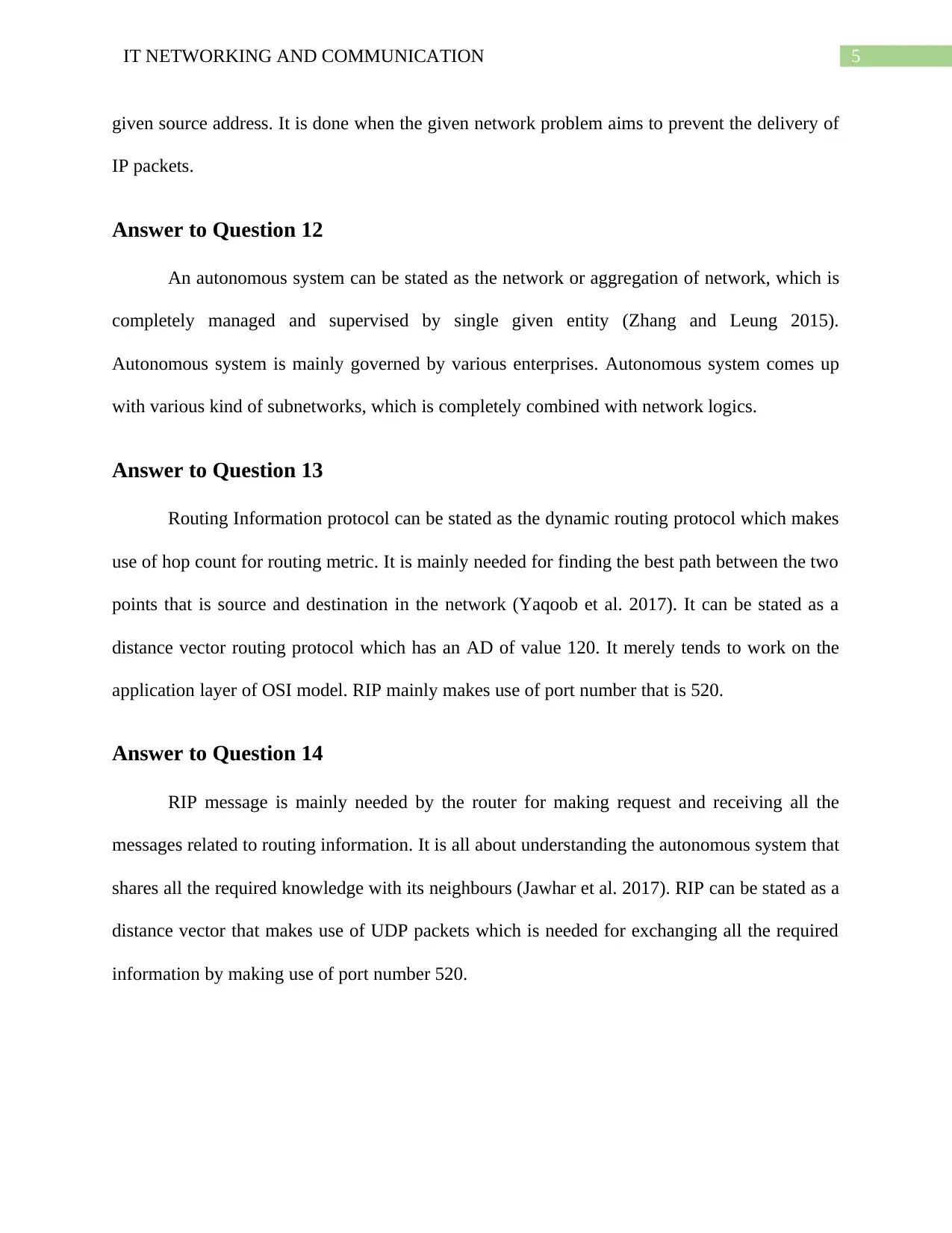
5IT NETWORKING AND COMMUNICATION
given source address. It is done when the given network problem aims to prevent the delivery of
IP packets.
Answer to Question 12
An autonomous system can be stated as the network or aggregation of network, which is
completely managed and supervised by single given entity (Zhang and Leung 2015).
Autonomous system is mainly governed by various enterprises. Autonomous system comes up
with various kind of subnetworks, which is completely combined with network logics.
Answer to Question 13
Routing Information protocol can be stated as the dynamic routing protocol which makes
use of hop count for routing metric. It is mainly needed for finding the best path between the two
points that is source and destination in the network (Yaqoob et al. 2017). It can be stated as a
distance vector routing protocol which has an AD of value 120. It merely tends to work on the
application layer of OSI model. RIP mainly makes use of port number that is 520.
Answer to Question 14
RIP message is mainly needed by the router for making request and receiving all the
messages related to routing information. It is all about understanding the autonomous system that
shares all the required knowledge with its neighbours (Jawhar et al. 2017). RIP can be stated as a
distance vector that makes use of UDP packets which is needed for exchanging all the required
information by making use of port number 520.
given source address. It is done when the given network problem aims to prevent the delivery of
IP packets.
Answer to Question 12
An autonomous system can be stated as the network or aggregation of network, which is
completely managed and supervised by single given entity (Zhang and Leung 2015).
Autonomous system is mainly governed by various enterprises. Autonomous system comes up
with various kind of subnetworks, which is completely combined with network logics.
Answer to Question 13
Routing Information protocol can be stated as the dynamic routing protocol which makes
use of hop count for routing metric. It is mainly needed for finding the best path between the two
points that is source and destination in the network (Yaqoob et al. 2017). It can be stated as a
distance vector routing protocol which has an AD of value 120. It merely tends to work on the
application layer of OSI model. RIP mainly makes use of port number that is 520.
Answer to Question 14
RIP message is mainly needed by the router for making request and receiving all the
messages related to routing information. It is all about understanding the autonomous system that
shares all the required knowledge with its neighbours (Jawhar et al. 2017). RIP can be stated as a
distance vector that makes use of UDP packets which is needed for exchanging all the required
information by making use of port number 520.
⊘ This is a preview!⊘
Do you want full access?
Subscribe today to unlock all pages.

Trusted by 1+ million students worldwide
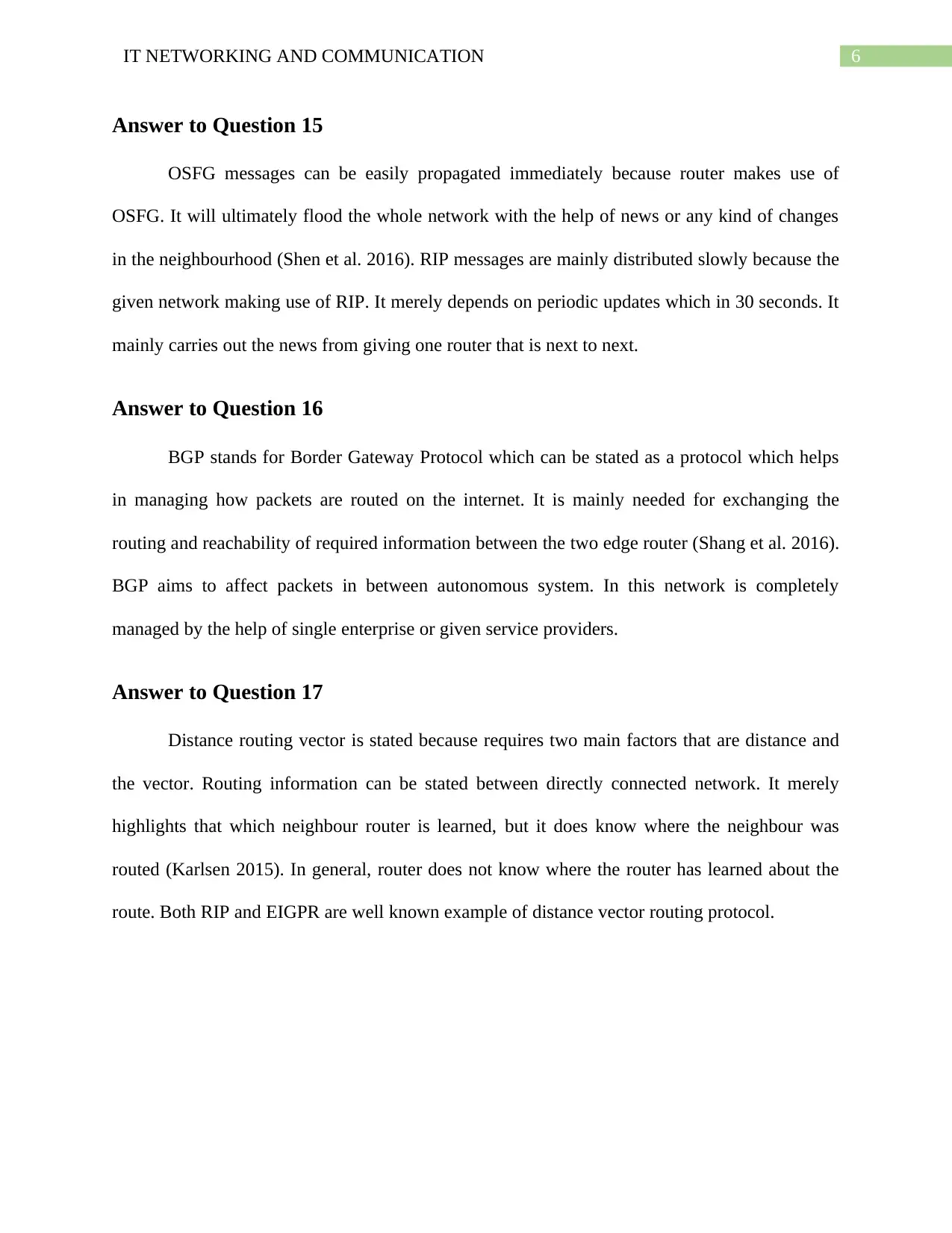
6IT NETWORKING AND COMMUNICATION
Answer to Question 15
OSFG messages can be easily propagated immediately because router makes use of
OSFG. It will ultimately flood the whole network with the help of news or any kind of changes
in the neighbourhood (Shen et al. 2016). RIP messages are mainly distributed slowly because the
given network making use of RIP. It merely depends on periodic updates which in 30 seconds. It
mainly carries out the news from giving one router that is next to next.
Answer to Question 16
BGP stands for Border Gateway Protocol which can be stated as a protocol which helps
in managing how packets are routed on the internet. It is mainly needed for exchanging the
routing and reachability of required information between the two edge router (Shang et al. 2016).
BGP aims to affect packets in between autonomous system. In this network is completely
managed by the help of single enterprise or given service providers.
Answer to Question 17
Distance routing vector is stated because requires two main factors that are distance and
the vector. Routing information can be stated between directly connected network. It merely
highlights that which neighbour router is learned, but it does know where the neighbour was
routed (Karlsen 2015). In general, router does not know where the router has learned about the
route. Both RIP and EIGPR are well known example of distance vector routing protocol.
Answer to Question 15
OSFG messages can be easily propagated immediately because router makes use of
OSFG. It will ultimately flood the whole network with the help of news or any kind of changes
in the neighbourhood (Shen et al. 2016). RIP messages are mainly distributed slowly because the
given network making use of RIP. It merely depends on periodic updates which in 30 seconds. It
mainly carries out the news from giving one router that is next to next.
Answer to Question 16
BGP stands for Border Gateway Protocol which can be stated as a protocol which helps
in managing how packets are routed on the internet. It is mainly needed for exchanging the
routing and reachability of required information between the two edge router (Shang et al. 2016).
BGP aims to affect packets in between autonomous system. In this network is completely
managed by the help of single enterprise or given service providers.
Answer to Question 17
Distance routing vector is stated because requires two main factors that are distance and
the vector. Routing information can be stated between directly connected network. It merely
highlights that which neighbour router is learned, but it does know where the neighbour was
routed (Karlsen 2015). In general, router does not know where the router has learned about the
route. Both RIP and EIGPR are well known example of distance vector routing protocol.
Paraphrase This Document
Need a fresh take? Get an instant paraphrase of this document with our AI Paraphraser
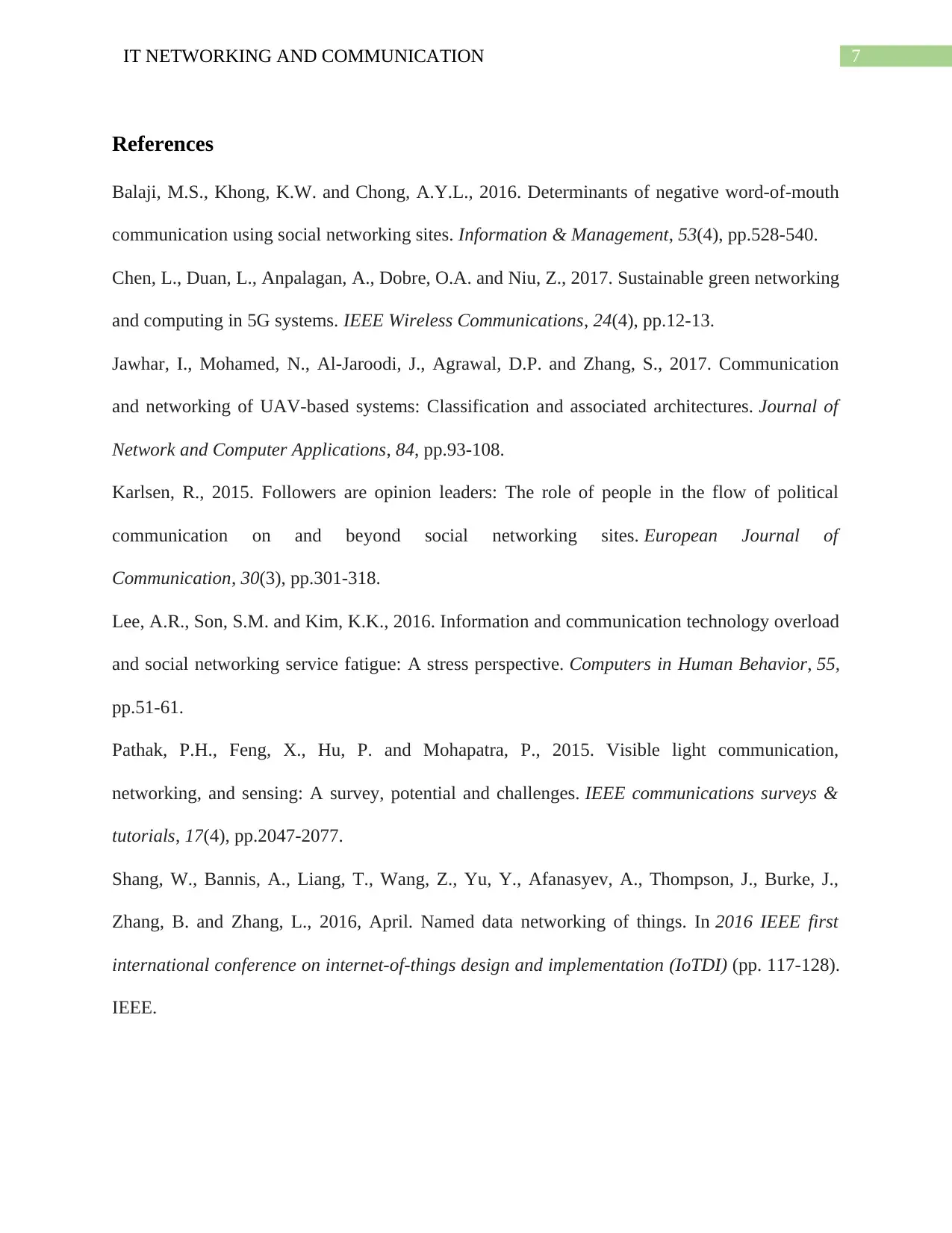
7IT NETWORKING AND COMMUNICATION
References
Balaji, M.S., Khong, K.W. and Chong, A.Y.L., 2016. Determinants of negative word-of-mouth
communication using social networking sites. Information & Management, 53(4), pp.528-540.
Chen, L., Duan, L., Anpalagan, A., Dobre, O.A. and Niu, Z., 2017. Sustainable green networking
and computing in 5G systems. IEEE Wireless Communications, 24(4), pp.12-13.
Jawhar, I., Mohamed, N., Al-Jaroodi, J., Agrawal, D.P. and Zhang, S., 2017. Communication
and networking of UAV-based systems: Classification and associated architectures. Journal of
Network and Computer Applications, 84, pp.93-108.
Karlsen, R., 2015. Followers are opinion leaders: The role of people in the flow of political
communication on and beyond social networking sites. European Journal of
Communication, 30(3), pp.301-318.
Lee, A.R., Son, S.M. and Kim, K.K., 2016. Information and communication technology overload
and social networking service fatigue: A stress perspective. Computers in Human Behavior, 55,
pp.51-61.
Pathak, P.H., Feng, X., Hu, P. and Mohapatra, P., 2015. Visible light communication,
networking, and sensing: A survey, potential and challenges. IEEE communications surveys &
tutorials, 17(4), pp.2047-2077.
Shang, W., Bannis, A., Liang, T., Wang, Z., Yu, Y., Afanasyev, A., Thompson, J., Burke, J.,
Zhang, B. and Zhang, L., 2016, April. Named data networking of things. In 2016 IEEE first
international conference on internet-of-things design and implementation (IoTDI) (pp. 117-128).
IEEE.
References
Balaji, M.S., Khong, K.W. and Chong, A.Y.L., 2016. Determinants of negative word-of-mouth
communication using social networking sites. Information & Management, 53(4), pp.528-540.
Chen, L., Duan, L., Anpalagan, A., Dobre, O.A. and Niu, Z., 2017. Sustainable green networking
and computing in 5G systems. IEEE Wireless Communications, 24(4), pp.12-13.
Jawhar, I., Mohamed, N., Al-Jaroodi, J., Agrawal, D.P. and Zhang, S., 2017. Communication
and networking of UAV-based systems: Classification and associated architectures. Journal of
Network and Computer Applications, 84, pp.93-108.
Karlsen, R., 2015. Followers are opinion leaders: The role of people in the flow of political
communication on and beyond social networking sites. European Journal of
Communication, 30(3), pp.301-318.
Lee, A.R., Son, S.M. and Kim, K.K., 2016. Information and communication technology overload
and social networking service fatigue: A stress perspective. Computers in Human Behavior, 55,
pp.51-61.
Pathak, P.H., Feng, X., Hu, P. and Mohapatra, P., 2015. Visible light communication,
networking, and sensing: A survey, potential and challenges. IEEE communications surveys &
tutorials, 17(4), pp.2047-2077.
Shang, W., Bannis, A., Liang, T., Wang, Z., Yu, Y., Afanasyev, A., Thompson, J., Burke, J.,
Zhang, B. and Zhang, L., 2016, April. Named data networking of things. In 2016 IEEE first
international conference on internet-of-things design and implementation (IoTDI) (pp. 117-128).
IEEE.
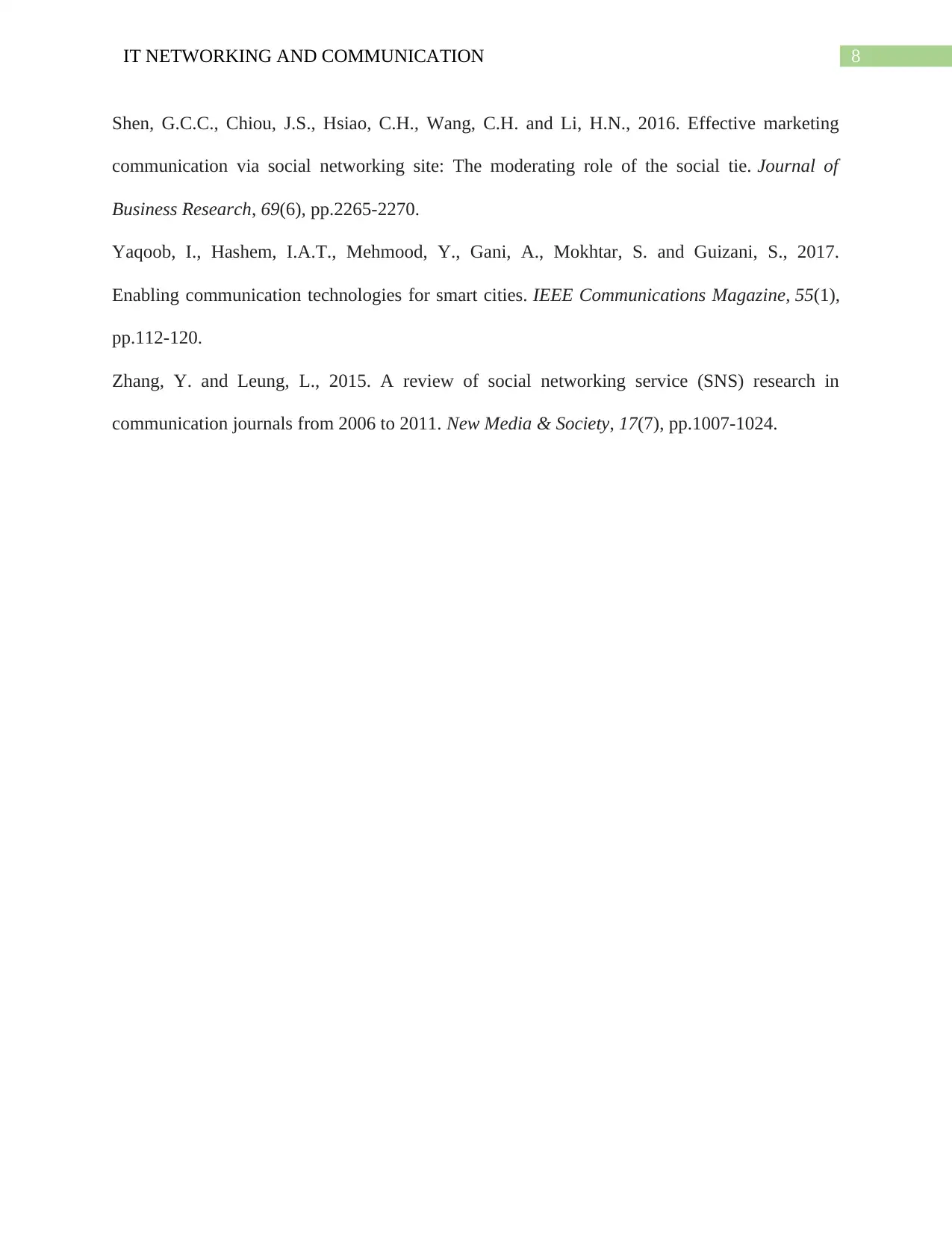
8IT NETWORKING AND COMMUNICATION
Shen, G.C.C., Chiou, J.S., Hsiao, C.H., Wang, C.H. and Li, H.N., 2016. Effective marketing
communication via social networking site: The moderating role of the social tie. Journal of
Business Research, 69(6), pp.2265-2270.
Yaqoob, I., Hashem, I.A.T., Mehmood, Y., Gani, A., Mokhtar, S. and Guizani, S., 2017.
Enabling communication technologies for smart cities. IEEE Communications Magazine, 55(1),
pp.112-120.
Zhang, Y. and Leung, L., 2015. A review of social networking service (SNS) research in
communication journals from 2006 to 2011. New Media & Society, 17(7), pp.1007-1024.
Shen, G.C.C., Chiou, J.S., Hsiao, C.H., Wang, C.H. and Li, H.N., 2016. Effective marketing
communication via social networking site: The moderating role of the social tie. Journal of
Business Research, 69(6), pp.2265-2270.
Yaqoob, I., Hashem, I.A.T., Mehmood, Y., Gani, A., Mokhtar, S. and Guizani, S., 2017.
Enabling communication technologies for smart cities. IEEE Communications Magazine, 55(1),
pp.112-120.
Zhang, Y. and Leung, L., 2015. A review of social networking service (SNS) research in
communication journals from 2006 to 2011. New Media & Society, 17(7), pp.1007-1024.
⊘ This is a preview!⊘
Do you want full access?
Subscribe today to unlock all pages.

Trusted by 1+ million students worldwide
1 out of 9
Related Documents
Your All-in-One AI-Powered Toolkit for Academic Success.
+13062052269
info@desklib.com
Available 24*7 on WhatsApp / Email
![[object Object]](/_next/static/media/star-bottom.7253800d.svg)
Unlock your academic potential
Copyright © 2020–2025 A2Z Services. All Rights Reserved. Developed and managed by ZUCOL.





